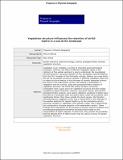Files in this item
Vegetation structure influences the retention of airfall tephra in a sub-Arctic landscape
Item metadata
| dc.contributor.author | Cutler, Nick | |
| dc.contributor.author | Bailey, Richard | |
| dc.contributor.author | Hickson, Katie | |
| dc.contributor.author | Streeter, Richard Thomas | |
| dc.contributor.author | Dugmore, Andrew J | |
| dc.date.accessioned | 2016-05-17T10:30:03Z | |
| dc.date.available | 2016-05-17T10:30:03Z | |
| dc.date.issued | 2016-10-17 | |
| dc.identifier | 242058086 | |
| dc.identifier | 5793c932-cffb-460a-b331-2966a387bb6c | |
| dc.identifier | 84991687162 | |
| dc.identifier | 000386007400002 | |
| dc.identifier.citation | Cutler , N , Bailey , R , Hickson , K , Streeter , R T & Dugmore , A J 2016 , ' Vegetation structure influences the retention of airfall tephra in a sub-Arctic landscape ' , Progress in Physical Geography , vol. 40 , no. 5 , pp. 661-675 . https://doi.org/10.1177/0309133316650618 | en |
| dc.identifier.issn | 0309-1333 | |
| dc.identifier.other | ORCID: /0000-0003-2261-4540/work/64697928 | |
| dc.identifier.uri | https://hdl.handle.net/10023/8813 | |
| dc.description.abstract | Vegetation cover mediates a number of important geomorphological processes. However, the effect of different vegetation types on the retention of fine aeolian sediment is poorly understood. We investigated this phenomenon, using the retention of fine, pyroclastic material (tephra) from the 2011 eruption of the Grímsvötn volcano, Iceland, as a case study. We set out to quantify structural variation in different vegetation types and to relate structural metrics to the thickness of recently deposited volcanic ash layers in the sedimentary section. We utilised a combination of vegetation and soil surveys, along with photogrammetric analysis of vegetation structure. We found that indices of plant community composition were a poor proxy for vegetation structure and were largely unrelated to tephra thickness. However, structural metrics, derived from photogrammetric analysis, were clearly related to variations in tephra layer thickness at a landscape scale and tephra layers under shrub patches were significantly thicker than those outside the shrub canopy. We therefore concluded that a) vegetation cover was a critical factor in the retention of fine aeolian sediment for deposit depths up to few centimetres and b) structural variation in vegetation cover played a major role in determining the configuration of tephra deposits in the sedimentary section. These findings have implications for the analysis of ancient volcanic eruptions and archaeological/palaeoenvironmental reconstructions based on the interpretation of tephra deposits. Furthermore, they present the possibility that the detailed form of tephra layers may be used as a proxy for palaeo vegetation structure. | |
| dc.format.extent | 1549423 | |
| dc.language.iso | eng | |
| dc.relation.ispartof | Progress in Physical Geography | en |
| dc.subject | Aeolian sediment | en |
| dc.subject | Tephrochronology | en |
| dc.subject | Iceland | en |
| dc.subject | Photogrammetric analysis | en |
| dc.subject | Vegetation structure | en |
| dc.subject | GE Environmental Sciences | en |
| dc.subject | NDAS | en |
| dc.subject.lcc | GE | en |
| dc.title | Vegetation structure influences the retention of airfall tephra in a sub-Arctic landscape | en |
| dc.type | Journal article | en |
| dc.contributor.institution | University of St Andrews. Geography & Sustainable Development | en |
| dc.contributor.institution | University of St Andrews. Bell-Edwards Geographic Data Institute | en |
| dc.identifier.doi | 10.1177/0309133316650618 | |
| dc.description.status | Peer reviewed | en |
| dc.identifier.url | http://ppg.sagepub.com/ | en |
This item appears in the following Collection(s)
Items in the St Andrews Research Repository are protected by copyright, with all rights reserved, unless otherwise indicated.

